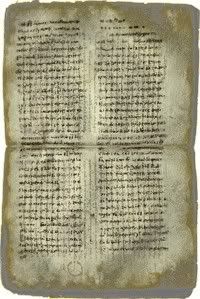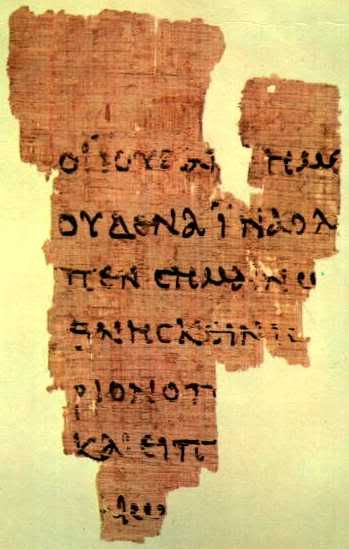Archimedes, the Crusades, Palimpsests & the Bible
 The oldest known manuscript of Archimedes (287-212 BC) was discovered in 1906. The 10th century Greek text of a previously missing treatise had been scraped off of the vellum and over-written by a Latin devotional text 200 years afterwards. This type of over-written text is called a palimpsest and is not unusual in ancient manuscripts where quality writing materials were often scarce.
The oldest known manuscript of Archimedes (287-212 BC) was discovered in 1906. The 10th century Greek text of a previously missing treatise had been scraped off of the vellum and over-written by a Latin devotional text 200 years afterwards. This type of over-written text is called a palimpsest and is not unusual in ancient manuscripts where quality writing materials were often scarce.
The manuscript as it appears to the eye
A CNN News story today explained how particle accelerator technology is being used to decipher the final 20% of the document.
A web page dedicated to this manuscript presents a historical context that is every bit as good as an Indiana Jones movie.

The original (hidden) text viewed digitally enhanced
It is believed that the manuscript was copied in Constantinople, which was then called Byzantium, the capital of the shrinking remnant of the Eastern Roman Empire.
In 1240, the Fourth Crusade, not strong or foolish enough to engage the vastly superior Muslim military firmly entrenched in Jerusalem and the Holy Land, turned its eyes on the Christian Orthodox bastion of Constantinople instead.
The upshot of the story is that, in defense of the city, defenders set fires that destroyed much of the city and many of the treasures it contained, including its vast library of manuscripts. After the city's fall, the crusaders pillaged the city resulting in a fire that consumed even more of the city than had the first.
Somehow, this manuscript of Archimedes survived all of that. Singe marks still mar the document but whether or not they came from that siege of Constantinople is difficult to tell.

Hagia Sophia
(Later, after being restored to the Byzantine leaders, Constantinople remained a Christian city until the Ottomans captured it in 1453 and converted it into the Muslim capital of the Ottoman Empire. It was at this time, by the way, that the great Christian Cathedral, Hagia Sophia, was converted into a mosque.)
Meanwhile, it is believed that the manuscript found its way to the Mar Saba Monastery, located between Bethlehem and the Dead Sea, and then, eventually, to the Greek Patriarchate in Jerusalem.
Next it showed up back in Constantinople where, in 1846, its existence was first noted but its identity and value were not recognized. In 1906, it was finally identified as a copy of Archimedes' "Method of Mechanical Theorems."
It then disappeared once again only to reappear in a private collection in Paris. In 1989 it was sold to its present owner for $2 million.

Text from Gospel of John 16 dated 130 AD
Closing Note: As with so many other ancient writers, this oldest and unique Archimedes document dates nearly 1200 years after it was first written. This is also true of Plato, Aristotle and everyone else you could possibly think of. The exception to this rule is the Bible. The earliest New Testament manuscript is a papyrus fragment from the Gospel of John dated less than 100 years after the Gospel was written. Thousands of other fragments and complete New and Old Testaments are also extant from the years that immediately followed. Scholars assume that the Greek texts of Archimedes and Aristotle are essentially correct even with only one manuscript copy with over a thousand years separating it from its origin. Why, then, do so many people question the authenticity of the New Testament?


<< Home